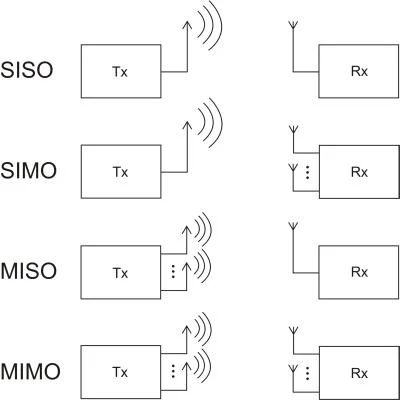MIMO
This page describes about MIMO basics,MIMO types and MIMO test and measurement solution providers.
Multiple Input Multiple Output is the full form of MIMO. Let us understand what input and output refers with. Following figure mentions antennas, for this case there are two antennas in Transmit i.e. Tx and two antennas are in Receive i.e. Rx. Tx refers to antennas in the Transmitting device and Rx refers antennas in the receiving device at some distance from the Transmit location. Between the Transmitting and Receiving device there is channel, which is marked with arrows. Here input refers signal is going into the channel and output refers signal is coming out of the channel. Hence Input and Output are with respect to the channel.

source of figure: wikimedia commons
SIMO means single input and multiple output. MISO means multiple input and single output. You are already aware of System without multiple antennas which is referred as SISO i.e. Single Input Single Output.
It is very important to know terminology for MIMO. If it is written on the device as '2x3 MIMO' means two antennas are used for transmission and 3 are used for reception.
There are two main types of MIMO.
Spatial multiplexing (SM):
in which different set of data are transmitted from the transmitting antennas hence
it will double the data rate for 2 transmitting antennas.
Space time block coding (STBC):
in which copy of the same data which have been transmitted from the two antennas at time instant T1
is transmitted at
time instant T2. It will not be the exact copy but it has been manipulated. This will help in recovering
the transmitting symbols after the multipath channel. This does not help in increase of data rate but helps
in extending the coverage or range.
There are systems where both coverage and datarate are required to be good, beam forming is often used in conjunction with MIMO of special multiplexing type. Beam forming multiply transmit signal with vector or matrix to achieve amplification of the transmitting vector.
Now-a-days MIMO is used in many next generation and current technologies for example Mobile
WiMAX as per 802.16e standard, LTE as per 3GPP standard, 802.16m, 802.20, 802.11n, 802.11-ac etc.
List of Companies providing MIMO Device Test Equipments are mentioned below.
Advantages of MIMO:
- Increased coverage with appropriate MIMO technique for example STBC
- Increased data rate with SM
Disadvantages of MIMO:
- For the case of mobile handset, complexity increses to accommodate multiple antennas in limited space.
Companies-MIMO Test and Measurement solutions
Agilent Technologies
Rohde and Schwarz
Keithley Instruments Inc.
National Instruments
Anritsu corporation
